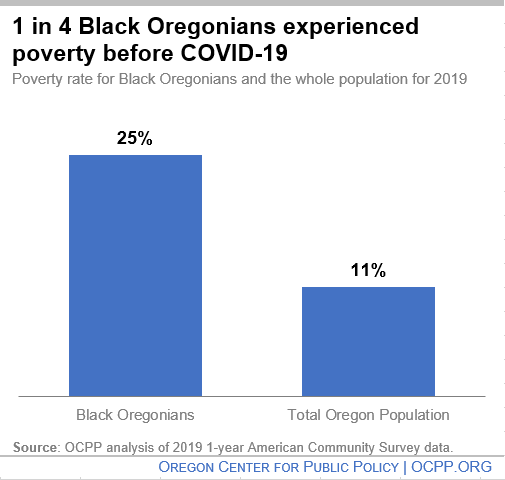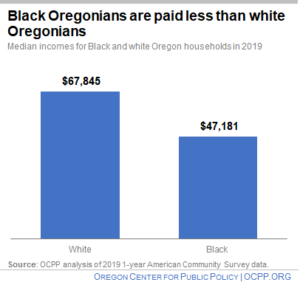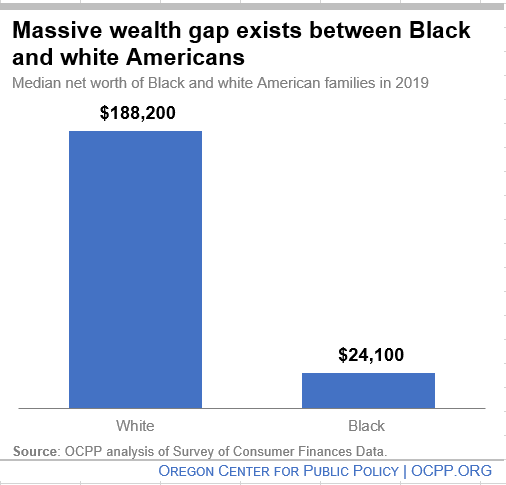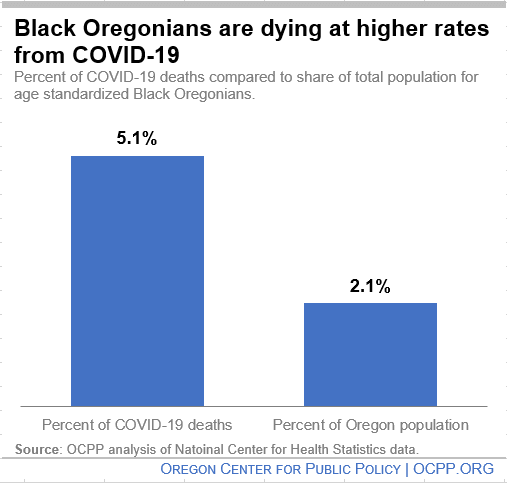A century after the signing of the Emancipation Proclamation, the Rev. Dr. Martin Luther King, Jr. delivered one of the greatest speeches in American history. The “Negro is still not free,” he observed in I Have a Dream. “One hundred years later, the life of the Negro is still sadly crippled by the manacles of segregation and the chains of discrimination. One hundred years later, the Negro lives on a lonely island of poverty in the midst of a vast ocean of material prosperity.”
Dr. King helped lead our nation toward greater freedom and justice for Black Americans. And yet, today, Black people in Oregon and across our country still face many of the same struggles that Dr. King fought so hard against. The societal ills of police brutality, discrimination, and economic inequality that Dr. King protested against are alive and well today.
On this Martin Luther King, Jr., Day we look at the economic reality Black Oregonians face. While much of this data is from 2019, before the COVID-19 virus upended our economy, we know that Black Americans have borne the brunt of the economic and public health crises of the past year.

In 2019, the most recent year with data available, one in four Black Oregonians had incomes below the federal poverty line. This was more than twice the poverty rate for the overall Oregon population, which stood at 11 percent, or just over one in 10. Keep in mind, the poverty line is an out-of-date measure of what it truly takes to make ends meet.
Oregon’s long history of excluding, assaulting, and discriminating against Black Oregonians leaves them with immense barriers to economic security.

Prior to the pandemic, the income of typical Black Oregon households lagged that of other Oregonians. The typical Black household is paid over $20,000 less per year than the typical white household. Discrimination; job segregation; growing economic inequality; and the criminalization of Black lives all contribute to Black Oregonians having less income than white residents of the state. With a 2019 median income of about $47,000, Black households have fewer resources to cover basic needs.

While reliable data on wealth does not exist at a state level, national data shows there is a large gap between the wealth of Black and white Americans. In 2019, the typical net worth of white families was $164,000 higher than that of Black families. This is despite the fact that, since 2016, Black wealth had been growing at a faster rate than white — at least up until the pandemic. Data on wealth and assets from the Federal Reserve also shows that Black Americans inherit assets at a lower rate than white Americans. They also are less likely to own homes or have access to an employer-sponsored retirement account.
Lack of wealth means that Black Americans have a smaller financial cushion to protect them during economic emergencies, like the present one, and are less able to invest in themselves and their families. The Urban League of Portland had this to say about the importance of wealth building for Black families:
Financial stability of the next generation needs to be a priority for policymakers; it is an opportunity to advance the security of the Black middle class. Improving wages and income, entrepreneurship opportunities, financial literacy and retirement security and ensuring affordable childcare can all play a role in building equity within Oregon’s Black communities.

In addition to still facing economic injustices, Black Oregonians today are dying at higher rates from COVID-19. When controlling for age, Black Oregonians make up 5.1 percent of all COVID-19 deaths in Oregon, while only making up 2.1 percent of the population. The high rates of COVID-19 cases and deaths among communities of color likely stems, in part, from the fact that Black and brown Americans are more likely to work in front-line jobs, where they face greater risk than those able to work from home.
Nearly 60 years later, Dr. King’s dream remains unfulfilled. It’s up to us to move forward and achieve true justice and freedom for all by implementing public policies that end racial disparities once and for all.
How far we still must go to fulfill Dr. King’s dream
How far we still must go to fulfill Dr. King’s dream
How far we still must go to fulfill Dr. King’s dream
A century after the signing of the Emancipation Proclamation, the Rev. Dr. Martin Luther King, Jr. delivered one of the greatest speeches in American history. The “Negro is still not free,” he observed in I Have a Dream. “One hundred years later, the life of the Negro is still sadly crippled by the manacles of segregation and the chains of discrimination. One hundred years later, the Negro lives on a lonely island of poverty in the midst of a vast ocean of material prosperity.”
Dr. King helped lead our nation toward greater freedom and justice for Black Americans. And yet, today, Black people in Oregon and across our country still face many of the same struggles that Dr. King fought so hard against. The societal ills of police brutality, discrimination, and economic inequality that Dr. King protested against are alive and well today.
On this Martin Luther King, Jr., Day we look at the economic reality Black Oregonians face. While much of this data is from 2019, before the COVID-19 virus upended our economy, we know that Black Americans have borne the brunt of the economic and public health crises of the past year.
In 2019, the most recent year with data available, one in four Black Oregonians had incomes below the federal poverty line. This was more than twice the poverty rate for the overall Oregon population, which stood at 11 percent, or just over one in 10. Keep in mind, the poverty line is an out-of-date measure of what it truly takes to make ends meet.
Oregon’s long history of excluding, assaulting, and discriminating against Black Oregonians leaves them with immense barriers to economic security.
Prior to the pandemic, the income of typical Black Oregon households lagged that of other Oregonians. The typical Black household is paid over $20,000 less per year than the typical white household. Discrimination; job segregation; growing economic inequality; and the criminalization of Black lives all contribute to Black Oregonians having less income than white residents of the state. With a 2019 median income of about $47,000, Black households have fewer resources to cover basic needs.
While reliable data on wealth does not exist at a state level, national data shows there is a large gap between the wealth of Black and white Americans. In 2019, the typical net worth of white families was $164,000 higher than that of Black families. This is despite the fact that, since 2016, Black wealth had been growing at a faster rate than white — at least up until the pandemic. Data on wealth and assets from the Federal Reserve also shows that Black Americans inherit assets at a lower rate than white Americans. They also are less likely to own homes or have access to an employer-sponsored retirement account.
Lack of wealth means that Black Americans have a smaller financial cushion to protect them during economic emergencies, like the present one, and are less able to invest in themselves and their families. The Urban League of Portland had this to say about the importance of wealth building for Black families:
In addition to still facing economic injustices, Black Oregonians today are dying at higher rates from COVID-19. When controlling for age, Black Oregonians make up 5.1 percent of all COVID-19 deaths in Oregon, while only making up 2.1 percent of the population. The high rates of COVID-19 cases and deaths among communities of color likely stems, in part, from the fact that Black and brown Americans are more likely to work in front-line jobs, where they face greater risk than those able to work from home.
Nearly 60 years later, Dr. King’s dream remains unfulfilled. It’s up to us to move forward and achieve true justice and freedom for all by implementing public policies that end racial disparities once and for all.
Audrey Mechling
Action Plan for the People
How to Build Economic Justice in Oregon
relevant topics
Hunger increased following the end of COVID-era policies. Then Congress slashed food assistance.
How Trump Is Hiding Hunger and Why Poverty Persists
Trump administration wants to hide the facts about hunger levels. Oregon should fill the void.
Action Plan for the People
How to Build Economic Justice in Oregon
Latest Posts
End the Oregon Tax Break for Rich Investors
QSBS, a tax break for rich investors, was indefensible before Congress expanded it. It’s even less defensible now.
Hunger increased following the end of COVID-era policies. Then Congress slashed food assistance.
One in seven Oregonians is food insecure, and recent congressional action threatens to worsen hunger
Close Tax Loopholes for Corporations and the Rich, Tap Reserves
Statement on the December Revenue Forecast by the Oregon Center for Public Policy, SEIU 503, Family Forward Oregon, and Oregon
Your donation helps build Economic Justice in Oregon
Your donation helps build Economic Justice in Oregon